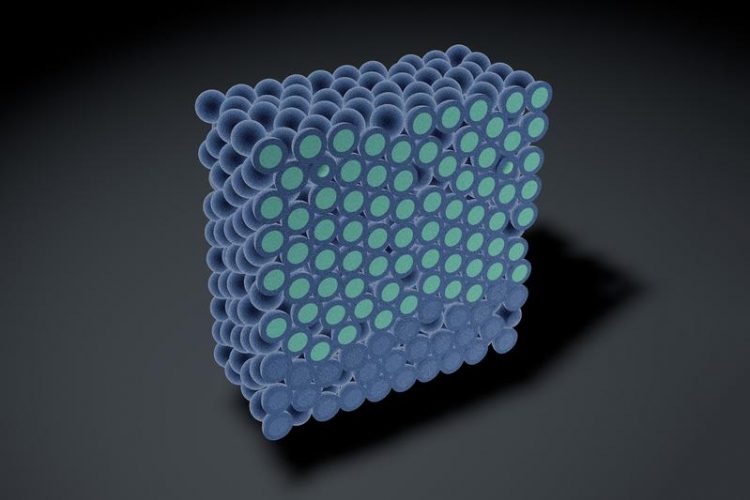Preserved and fresh – Neutrons show details of the freeze drying process

Freeze drying of maltodextrin particles (dark blue = sugar matrix; turquoise = ice): The radial drying front in the particles runs from the outside to the inside, the planar front from bottom to top. W. Schürmann / TUM
Who doesn’t know the story: time in the morning is short, we have to get through breakfast quickly. The fruit muesli is poured into the bowl, a few spoonfuls of yogurt on top, finished. Here, many people have perhaps started to speculate, how exactly do the raspberries look so fresh and tasty.
The technology which makes this possible is freeze drying. Scientists at the Technical University of Munich (TUM) and the Otto von Guericke University Magdeburg have now been able to examine this process more closely with the help of neutrons. For the first time, they succeeded in observing the direct transition from ice to water vapor during the freeze drying of particles in an experiment.
Why do raspberries in muesli always look so fresh and tasty?
“Freeze drying is a process which is mainly used in the pharmaceutical and food industries,” explains Sebastian Gruber, lead author of the study and doctoral candidate in food technology at the TUM.
When freeze drying, the objects containing water are frozen and placed in a vacuum chamber. Under low pressure, heat is added which sublimates the frozen water, i.e., it transitions directly from its solid state to its gaseous state. The dehydrated, unchanged structure of the material remains.
This is why freeze-dried raspberries look as though they have been freshly picked. But it isn’t just about the looks: Foods retain their taste and medicines are preserved without losing their efficacy.
In the literature, there are theoretical models about the freeze-drying process. “So far, however, no one has experimentally investigated the pattern according to which the ice in particles actually sublimes,” emphasizes Sebastian Gruber. It is precisely this sublimation front, meaning the area in which the ice vaporizes, which the researchers are interested in.
Neutrons make ice visible
The neutron radiography instrument ANTARES at the Garching research neutron source provides the ideal prerequisites for the experiment. Because neutrons make water visible.
“ANTARES is also particularly well suited to investigate samples under low pressure and low temperatures,” explains instrument scientist Dr. Michael Schulz from the TUM.
Using neutron radiography and tomography and the resulting 2D and 3D images, the scientists show that the ice sublimates from the particles of their sugar sample in a radial manner, and in a planar from the ground towards the center of the bed.
The findings will help to save time and costs
“Our aim is to further advance the research on the freeze-drying process in order to create better process conditions in the future,” Sebastian Gruber explains the motivation behind the research. “Because if the particle size, pressure or temperature cannot be coordinated in an ideal manner during sublimation, this can lead to a structural collapse and thus a loss in quality or efficacy.”
The industry is currently trying to counteract these undesired phenomena with longer drying processes. The behavior of the sublimations front, which has been experimentally confirmed for now, could contribute to minimizing the time taken and thus save energy and costs.
Prof. Dr.-Ing. Petra Först
Chair of Process Systems Engineering
Technical University of Munich
Gregor-Mendel-Straße 4, 85354 Freising, Germany
Phone: +49 8161 71-3289 – E-Mail: petra.foerst@tum.de
Sebastian Gruber, M.Sc.
Phone: +49 8161 71-4187 – E-Mail: sebi.gruber@tum.de
Estimation of the local sublimation front velocities from neutron radiography and tomography of particulate matter
S. Gruber, N. Vorhauer, M. Schulz, M. Hilmer, J. Peters, E. Tsotsas, P. Foerst
Chemical Engineering Science, 211, 16. Januar 2020, 115268
Link: https://doi.org/10.1016/j.ces.2019.115268
https://www.frm2.tum.de/en/ Website of the research neutron source Heinz Maier-Leibnitz (FRM II)
https://www.tum.de/nc/en/about-tum/news/press-releases/details/31407/ scientific results of the FRM II
http://svt.wzw.tum.de/en/ website of the Chair of Process Systems Engineering
https://www.tum.de/nc/die-tum/aktuelles/pressemitteilungen/details/35930/ press release in German
Media Contact
All latest news from the category: Life Sciences and Chemistry
Articles and reports from the Life Sciences and chemistry area deal with applied and basic research into modern biology, chemistry and human medicine.
Valuable information can be found on a range of life sciences fields including bacteriology, biochemistry, bionics, bioinformatics, biophysics, biotechnology, genetics, geobotany, human biology, marine biology, microbiology, molecular biology, cellular biology, zoology, bioinorganic chemistry, microchemistry and environmental chemistry.
Newest articles

Innovative 3D printed scaffolds offer new hope for bone healing
Researchers at the Institute for Bioengineering of Catalonia have developed novel 3D printed PLA-CaP scaffolds that promote blood vessel formation, ensuring better healing and regeneration of bone tissue. Bone is…

The surprising role of gut infection in Alzheimer’s disease
ASU- and Banner Alzheimer’s Institute-led study implicates link between a common virus and the disease, which travels from the gut to the brain and may be a target for antiviral…

Molecular gardening: New enzymes discovered for protein modification pruning
How deubiquitinases USP53 and USP54 cleave long polyubiquitin chains and how the former is linked to liver disease in children. Deubiquitinases (DUBs) are enzymes used by cells to trim protein…



